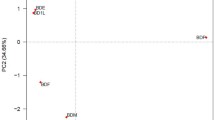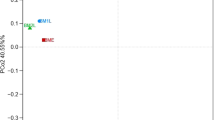Abstract
Insects have established close relationships with a wide variety of microorganisms, which play a key role in insect ecology and evolution. Fruit flies in the Tephritidae family have economic importance at the global level, including species such as Anastrepha obliqua, which is an important pest in the neotropical region. Although several studies have been performed on the microbiota associated with fruit flies, there are still large gaps in our knowledge about the bacterial communities on the genus Anastrepha. During this study, we used high-throughput sequencing to characterize the bacterial communities of the polyphagous fly A. obliqua, and we evaluated the effect of the life stage (larvae and adults) and host plant (three plant species) on the structure of these communities. Our results show that the bacterial communities in A. obliqua appears to be structured according to the insect life stage and the host plant. The predominant genera belonging to the phylum Proteobacteria were Wolbachia and Enterobacter in both larvae and adults, and they displayed differences in abundance between them, with Wolbachia sp. being more abundant in larvae and Enterobacter sp. being more abundant in adults. Differences in the structures of the bacterial communities were also observed according to the host plant with higher abundance of Enterobacter and Acetobacter bacteria in mango and plum fruits. Based on our results, it can be hypothesized that the bacterial communities on A. obliqua reorganize according to the needs of these insects during their different life stages and could also play an important role in the establishment of this fly species on different host plants. This study represents the first approach to understanding microorganism–insect interactions in fruit flies in Colombia.



Similar content being viewed by others
References
Dillon RJ, Dillon VM (2004) The gut bacteria of insects: nonpathogenic interactions. Annu Rev Entomol 49:71–92
Oliver KM, Russell JA, Moran NA, Hunter MS (2003) Facultative bacterial symbionts in aphids confer resistance to parasitic wasps. Proc Natl Acad Sci USA 100(4):1803–1807
Russell JA, Moran NA (2006) Costs and benefits of symbiont infection in aphids: variation among symbionts and across temperatures. Proc R Soc B 273(1586):603–610
Engel P, Moran NA (2013) The gut microbiota of insects-diversity in structure and function. FEMS Microbiol Rev 37(5):699–735
Douglas AE (2009) The microbial dimension in insect nutritional ecology. Funct Ecol 23:38–47
White IM, Elson-Harris MM (1992) Fruit flies of economic importance: their identification and bionomics. CAB International, Wallingford
Hill GT, Mitkowski NA, Aldrich-Wolfe L, Emele LR, Jurkonie DD, Ficke A, Maldonado-Ramirez S, Lynch ST, Nelsona EB (2000) Methods for assessing the composition and diversity of soil microbial communities. Appl Soil Ecol 15(1):25–36
Capuzzo C, Firrao G, Mazzon L, Squartini A, Girolami V (2005) ‘Candidatus Erwinia dacicola’, a coevolved symbiotic bacterium of the olive fly Bactrocera oleae (Gmelin). Int J Syst Evol Microbiol 55:1641–1647
Mazzon L, Piscedda A, Simonato M, Martinez-Sanudo I, Squartin A, Girolami V (2008) Presence of specific symbiotic bacteria in flies of the subfamily Tephritinae (Diptera: Tephritidae) and their phylogenetic relationships: proposal of ‘Candidatus Stammerula tephritidis’. Int J Syst Evol Microbiol 58:1277–1287
Behar A, Yuval B, Jurkevitch E (2005) Enterobacteria-mediated nitrogen fixation in natural populations of the fruit fly Ceratitis capitata. Mol Ecol 14:2637–2643
Boush GM, Matsumura F (1967) Insecticidal degradation by Pseudomonas melophthora, the bacterial symbiote of the apple maggot. J Econ Entomol 60:918–920
Behar A, Yuval B, Jurkevitch E (2008) Gut bacterial communities in the Mediterranean fruit fly (Ceratitis capitata) and their impact on host longevity. J Insect Physiol 54:1377–1383
Ben-Yosef M, Jurkevitch E, Yuval B (2008) Effect of bacteria on nutritional status and reproductive success of the Mediterranean fruit fly Ceratitis capitata. Physiol Entomol 33:145–154
Morrow JL, Frommer M, Shearman DC, Riegler M (2015) The microbiome of field-caught and laboratory-adapted Australian Tephritid fruit fly species with different host plant use and specialization. Microb Ecol 70:498–508
Malacrinò A, Campolo O, Medina RF, Palmeri V (2018) Instar- and host-associated differentiation of bacterial communities in the Mediterranean fruit fly Ceratitis capitata. PLoS ONE 13(3):e0194131
Andongma AA, Wan L, Dong YC, Li P, Desneux N, White JA, Niu CY (2015) Pyrosequencing reveals a shift in symbiotic bacteria populations across life stages of Bactrocera dorsalis. Sci Rep 5:9470
Yong H-S, Song S-L, Chua K-O, Lim P-E (2017) Microbiota associated with Bactrocera carambolae and B. dorsalis (Insecta: Tephritidae) revealed by next-generation sequencing of 16S rRNA gene. Meta Gene 11:189–196
Yong H-S, Song S-L, Chua K-O, Lim P-E (2017) High diversity of bacterial communities in developmental stages of Bactrocera carambolae (Insecta: Tephritidae) revealed by illumina MiSeq sequencing of 16S rRNA gene. Curr Microbiol 74:1076–1082
Liu SH, Chen Y, Li W, Tang GH, Yang Y, Jiang HB, Dou W, Wang JJ (2018) Diversity of bacterial communities in the intestinal tracts of two geographically distant populations of Bactrocera dorsalis (Diptera: Tephritidae). J Econ Entomol 111(6):2861–2868
Aluja M (1994) Bionomics and management of Anastrepha. Annu Rev Entomol 39:155–178
Coscrato VE, Braz ASK, Perondini ALP, Selivon D, Marino CL (2009) Wolbachia in Anastrepha fruit flies (Diptera: Tephritidae). Curr Microbiol 59:295–301
Martínez H, Toledo J, Liedo P, Mateos M (2012) Survey of heritable endosymbionts in Southern Mexico populations of the fruit fly species Anastrepha striata and A. ludens. Curr Microbiol 65:711–718
Mascarenhas RO, Prezotto LF, Perondini ALP, Marino CL, Selivon D (2016) Wolbachia in guilds of Anastrepha fruit flies (Tephritidae) and parasitoid wasps (Braconidae). Genet Mol Biol 39(4):600–610
Martínez AJ, Robacker DC, Garcia JA, Esau KL (1994) Laboratory and field olfactory attraction of the Mexican fruit fly (Diptera:Tephritidae) to metabolites of bacterial species. Fla Entomol 77:117–126
Hernández-Ortiz V, Aluja M (1993) Listado de especies del género neotropical Anastrepha (Diptera: Tephritidae) con notas sobre su distribución y plantas hospederas. Folia Entomol Mex 88:89–101
Ventura C, Briones-Roblero CI, Hernández E, Rivera-Orduna FN, Zúñiga G (2018) Comparative analysis of the gut bacterial community of four Anastrepha fruit flies (Diptera: Tephritidae) based on pyrosequencing. Curr Microbiol 75(8):966–976
Ferrari J, Scarborough CL, Godfray HCJ (2007) Genetic variation in the effect of a facultative symbiont on host-plant use by pea aphids. Oecologia 153(2):323–329
Yun J-H, Roh SW, Whon TW, Jung M-J et al (2014) Insect gut bacterial diversity determined by environmental habitat, diet, developmental stage, and phylogeny of host. Appl Environ Microbiol 80(17):5254–5264
Aguirre-Ramirez EJ, Velasco-Cuervo SM, Gallo-Franco JJ, Gonzales R, Carrejo NS, Toro-Perea N (2017) Genetic diversity and population structure of Anastrepha obliqua in southwestern Colombia. Entomol Exp Appl 164(3):291–304
Steyskal GC (1977) Pictorial key to species of the genus Anastrepha (Diptera: Tephritidae). Entomological Society of Washington press, Washington
Caraballo J (2001) Diagnosis y clave pictórica para las especies del género Anastrepha Schiner, 1986 (Diptera: Tephritidae) de importancia económica en Venezuela. Entomotrópica 16(3):157–164
Folmer O, Black M, Hoeh W, Lutz R, Vrijenhoek R (1994) DNA primers for amplification of mitochondrial cytochrome c oxidase subunit I from diverse metazoan invertebrates. Mol Mar Biol Biotechnol 3(5):294–299
Herlemann DPR, Labrenz M, Jürgens K, Bertilsson S, Waniek JJ, Andersson AF (2011) Transitions in bacterial communities along the 2000 km salinity gradient of the Baltic Sea. ISME J 5:1571–1579
Caporaso JG, Kuczynski J, Stombaugh J et al (2010) QIIME allows analysis of high-throughput community sequencing data. Nat Methods 7:335–336
Callahan BJ, McMurdie PJ, Rosen MJ, Han AW, Johnson AJ, Holmes SP (2016) DADA2: high-resolution sample inference from Illumina amplicon data. Nat Methods 13(7):581–583
McMurdie PJ, Holmes S (2013) Phyloseq: an R package for reproducible interactive analysis and graphics of microbiome census data. PLoS ONE 8(4):e61217
Kuzina LV, Peloquin JJ, Vacek DC, Miller TA (2001) Isolation and identification of bacteria associated with adult laboratory mexican fruit flies, Anastrepha ludens (Diptera: Tephritidae). Curr microbiol 42:290–294
Werren JH (1997) Biology of Wolbachia. Annu Rev Entomol 42:587–609
Hilgenboecker K, Hammerstein P, Schlattmann P, Telschow A, Werren JH (2008) How many species are infected with Wolbachia? A statistical analysis of current data. FEMS Microbiol Lett 281(2):215–220
Werren JH, Baldo L, Clark ME (2008) Wolbachia: master manipulators of invertebrate biology. Nat Rev Microbiol 6(10):741–751
Werren JH, Guo LR, Windsor D (1995) Distribution of Wolbachia in neotropical arthropods. Proc R Soc Lond B 262:197–220
Selivon D, Perondini ALP, Ribeiro AF, Marino CL, Lima MMA, Coscrato VE (2002) Wolbachia endosymbiont in a species of Anastrepha fraterculus complex (Diptera: Tephritidae). Invertebr Reprod Dev 42:121–127
Shi P, He Z, Li S, An X, Lv N, Ghanim M, Cuthbertson AGS, Ren S-X, Qiu B-L (2016) Wolbachia has two different localization patterns in whitefly Bemisia tabaci AsiaII7 species. PLoS ONE 11(9):e0162558
Sacchetti P, Granchietti A, Landini S, Viti C, Giovannetti L, Belcari A (2008) Relationships between the olive fly and bacteria. J Appl Entomol 132:682–689
Lauzon CR, Sjogren RE, Prokopy RJ (2000) Enzymatic capabilities of bacteria associated with apple maggot flies: a postulated role in attraction. J Chem Ecol 26:953–967
Robacker DC, Lauzon CR, He X (2004) Volatiles production and attractiveness to the Mexican fruit fly of Enterobacter agglomerans isolated from apple maggot and Mexican fruit flies. J Chem Ecol 30(7):1329–1347
Hagen KS (1966) Dependence of the olive fruit fly, Dacus oleae, larvae on symbiosis with Pseudomonas savastanoi for the utilization of olive. Nature 209:423–425
Howell CR, Beier RC, Stipanovic RD (1988) Production of ammonia by Enterobacter cloacae and its possible role in the biological control of Pythium preemergence damping-off by the bacterium. Phytopathology 78:1075–1078
Tsuchida T, Koga R, Shibao H, Matsumoto T, Fukatsu T (2002) Diversity and geographic distribution of secondary endosymbiotic bacteria in natural populations of the pea aphid. Acyrthosiphon pisum Mol Ecol 11(10):2123–2135
Oliver KM, Smith AH, Russell JA (2014) Defensive symbiosis in the real world -advancing ecological studies of heritable, protective bacteria in aphids and beyond. Funct Ecol 28:341–355
Aharon Y, Pasternak Z, Ben-Yosef M, Behar A, Lauzon C, Yuval B, Jurkevitch E (2013) Phylogenetic, metabolic, and taxonomic diversities shape Mediterranean fruit fly microbiotas during ontogeny. Appl Environ Microbiol 79(1):303–313
Hammer TJ, McMillan WO, Fierer N (2014) Metamorphosis of a butterfly-associated bacterial community. PLoS ONE 9(1):e86995
McFrederick QS, Wcislo WT, Hout MC, Mueller UG (2014) Host species and developmental stage, but not host social structure, affects bacterial community structure in socially polymorphic bees. FEMS Microbiol Ecol 88(2):398–406
Ben-Yosef M, Zaada DSY, Dudaniec RY, Pasternak Z et al (2017) Host-specific associations affect the microbiome of Philornis downsi, an introduced parasite to the Galápagos Islands. Mol Ecol 26:4644–4656
Yong H-S, Song S-L, Chua K-O, Lim P-E (2017) Predominance of Wolbachia endosymbiont in the microbiota across life stages of Bactrocera latifrons (Insecta: Tephritidae). Meta Gene 14:6–11
Moll RM, Romoser WS, Modrzakowski MC, Moncayo AC, Lerdthusnee K (2001) Meconialperitrophic membranes and the fate of midgut bacteria during mosquito (Diptera: Culicidae) metamorphosis. J Med Entomol 38:29–32
Johnston PR, Rolff J (2015) Host and symbiont jointly control gut microbiota during complete metamorphosis. PLoS Pathog 11(11):e1005246
Medina RF, Nachappa P, Tamborindeguy C (2011) Differences in bacterial diversity of host-associated populations of Phylloxera notabilis Pergande (Hemiptera: Phylloxeridae) in pecan and water hickory. J Evol Biol 24(4):761–771
Gauthier J-P, Outreman Y, Mieuzet L, Simon J-C (2015) Bacterial communities associated with host-adapted populations of pea aphids revealed by deep sequencing of 16S ribosomal DNA. PLoS ONE 10(3):e0120664
Vorholt JA (2012) Microbial life in the phyllosphere. Nat Rev Microbiol 10:828–840
Acknowledgements
We acknowledge the Colciencias program “jovenes investigadores e innovadores por la paz 2017” and the Universidad del Valle for the financial support provided. We are grateful to Elkin Aguirre and Sandra Velasco for their field assistance and contributions to the project. We thank Chrystian Sosa for his help in data analysis. We thank Mauricio Peñuela for a critical reading of the manuscript and his valuable comments on this paper.
Author information
Authors and Affiliations
Corresponding author
Ethics declarations
Conflict of interest
The author(s) declare no competing interests.
Additional information
Publisher's Note
Springer Nature remains neutral with regard to jurisdictional claims in published maps and institutional affiliations.
Electronic supplementary material
Below is the link to the electronic supplementary material.
Rights and permissions
About this article
Cite this article
Gallo-Franco, J.J., Toro-Perea, N. Variations in the Bacterial Communities in Anastrepha obliqua (Diptera: Tephritidae) According to the Insect Life Stage and Host Plant. Curr Microbiol 77, 1283–1291 (2020). https://doi.org/10.1007/s00284-020-01939-y
Received:
Accepted:
Published:
Issue Date:
DOI: https://doi.org/10.1007/s00284-020-01939-y




